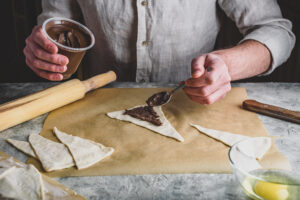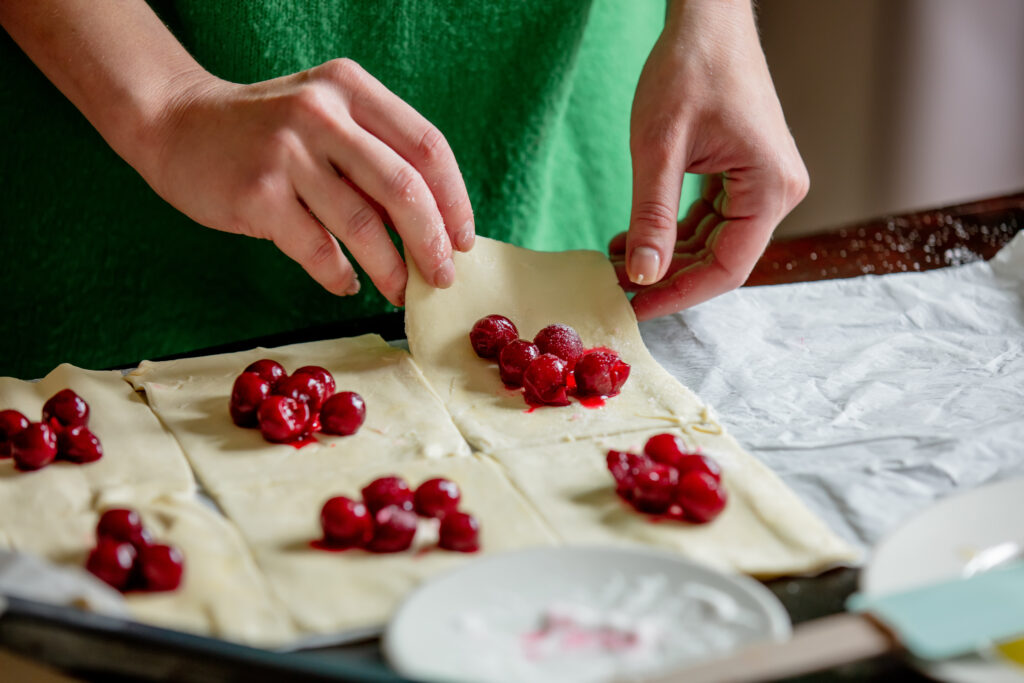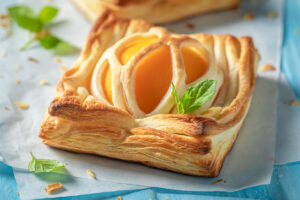Puff pastry, an essential element in the culinary arts, is renowned for its buttery, flaky layers, captivating bakers and chefs worldwide. This guide explores the critical question: Do I need to cook puff pastry before adding filling? Tracing its origins to France, puff pastry’s journey from a basic dough to a beacon of advanced baking skills is as intricate as its structure. Its ability to adapt to both sweet and savory dishes underscores the importance of understanding whether pre-cooking puff pastry is necessary. Learn more about what to avoid and best practices in our detailed article, What Things Should We Avoid with Puff Pastry?
As we delve into the essentials of puff pastry, including its rich history and its role in culinary arts, we also address the crucial technique of pre-cooking puff pastry before adding fillings, highlighting its versatility and significance in enhancing the quality of both sweet and savory creations.
Preparing Puff Pastry
Choosing between store-bought vs. homemade puff pastry marks the beginning of the baking journey. While store-bought options offer convenience, homemade versions allow for customization. Handling puff pastry correctly is crucial for achieving that perfect rise and flaky finish. Avoid common pitfalls such as overworking the dough or not chilling it sufficiently. For those opting for convenience without sacrificing quality, learning how to handle store-bought puff pastry is essential (The Kitchn) provides an excellent guide. Remember, whether you’re a novice or a seasoned baker, mastering the art of preparing puff pastry and incorporating puff pastry tips can elevate your dishes.
To Bake or Not to Bake Before Filling?
The culinary world often debates the necessity of pre-baking puff pastry before introducing fillings. This decision crucially depends on the final dish’s desired characteristics. Here, we delve deeper into the nuances of pre-baking puff pastry, ensuring bakers can achieve their intended results with precision and flair.
The Benefits of Pre-Baking
Pre-baking, or blind baking, serves a pivotal role in the realm of puff pastry creations. This technique is especially advantageous for:
- Preventing soggy bottoms in dishes with wet fillings
- Achieving a uniformly crisp and golden finish
Essentially, pre-baking acts as a shield, protecting the delicate layers of puff pastry from becoming waterlogged by moisture-heavy fillings. This method ensures that every bite is as crispy as intended, enhancing the overall dining experience.
When Pre-Baking Isn’t Necessary
Conversely, there are circumstances where skipping the pre-baking step can yield equally delightful results. These include:
- Dishes with drier fillings, where excess moisture isn’t a concern
- Recipes that call for a longer overall cooking time, allowing the pastry to cook thoroughly alongside the filling
In these scenarios, direct baking without pre-baking can simplify the preparation process without compromising the pastry’s texture or integrity.
Understanding the Right Approach
To master the art of puff pastry, recognizing when to bake puff pastry is crucial. Several factors influence this decision, including:
- The moisture content of the filling
- The baking time required for the filling to cook properly
- The desired texture of the final pastry
By considering these elements, bakers can tailor their approach to each specific recipe, ensuring optimal results.
Techniques for Baking Puff Pastry with Fillings
Delving into the realm of puff pastry unveils endless possibilities for culinary creativity. Whether you’re aiming for a savory meal or a sweet treat, the method of incorporating fillings plays a pivotal role in the dish’s success. This section explores the nuances of working with puff pastry, focusing on the techniques that elevate your baking.
Wrapping and Enclosing Techniques

The technique of wrapping or enclosing fillings in raw puff pastry stands as a cornerstone for both novice and experienced bakers. This method, known for its versatility, caters to a wide array of delectable creations, from savory to sweet. To achieve the perfect puff pastry experience, attention to detail is paramount, especially when it comes to moisture control and preparation of the fillings.
The Versatility of Enclosure
Puff pastry’s adaptability is showcased through an array of dishes:
- Savory pies and pastries, where the flakiness of the pastry complements the richness of the filling
- Fruit turnovers, offering a sweet and tart contrast encased in a buttery crust
- Cheese-filled delights, combining the sharpness of cheese with the subtle sweetness of pastry
Each category provides a canvas for culinary creativity, allowing bakers to experiment with flavors and textures.
Moisture Management: The Key to Perfection
The primary challenge in wrapping and enclosing fillings lies in managing moisture. Excess moisture can lead to a soggy bottom, detracting from the desired flakiness of the pastry. Here are strategies to ensure moisture is kept in check:
- Cool the Filling: Always allow your filling to cool before encasing it in pastry. Hot fillings can cause the butter in the pastry to melt prematurely, affecting texture.
- Thickness Matters: Adjust the thickness of the filling to suit the size of the pastry. Thicker fillings for larger pastries ensure even cooking and flavor distribution.
- Dry Ingredients: Incorporate dry ingredients like breadcrumbs or ground nuts to absorb excess moisture from fruit or meat fillings.
Techniques for Success
To wrap or enclose fillings effectively, follow these expert tips:
- Seal Edges Properly: Use a fork or your fingers to tightly seal the pastry edges, preventing the filling from leaking during baking.
- Venting: Make small slits on the top layer of the pastry to allow steam to escape, ensuring the filling cooks evenly without making the pastry soggy.
- Chill Before Baking: A brief stint in the refrigerator before baking can help the pastry maintain its shape and enhance the flakiness.
By adhering to these guidelines and employing patience and precision, bakers can ensure their wrapped or enclosed puff pastry dishes are both visually appealing and deliciously satisfying. Whether you’re creating a savory meal or a sweet treat, the key to success lies in the balance of flavors and the mastery of puff pastry techniques.
Layering for Depth and Flavor
The Art of Layering
Layering puff pastry with various fillings is not just a baking technique; it’s an art that infuses depth and flavor into every bite. This method transforms ordinary ingredients into extraordinary dishes, offering a sensory experience that delights both the palate and the eyes.
Key Components of Effective Layering
To master this technique, one must understand its foundational elements:
- Base Layer of Pastry: This is where it all begins, providing a crisp and flaky foundation.
- Evenly Spread Fillings: The heart of the dish, where flavors and textures play a central role.
- Top Layer of Pastry: Optional, but adds additional texture and encases the fillings beautifully.
A stellar example of this artistry in action is the luxurious deep-dish quiche, a dish that exemplifies how effective layering can elevate a simple quiche into a decadent meal. Cambrea Bakes offers an inspiring recipe for a deep-dish quiche that perfectly demonstrates these principles in action.
The Benefits of Layering
The benefits of this approach are manifold, ensuring a harmonious balance of flavors and textures:
- Ensures a balanced distribution of ingredients
- Creates a visually appealing dish
- Allows for a creative combination of fillings
Mastering the Technique
Achieving perfection in layering requires attention to detail and a bit of practice. Here are some tips to guide you:
- Select the Right Fillings: Choose fillings that complement each other and consider their moisture content.
- Keep the Pastry Cold: Work quickly to keep the pastry cold, ensuring a flakier result.
- Bake to Perfection: Understand your oven’s characteristics and adjust the baking time accordingly.
Sweet vs. Savory Considerations
When choosing between sweet and savory puff pastry recipes, the distinction is not merely about the fillings but also about the baking approach and final presentation:
- Savory Dishes: Opt for fillings like meats, vegetables, or cheeses. These may require pre-baking the pastry base to avoid sogginess.
- Sweet Dishes: Fillings can range from fruits to sweetened creams. These might benefit from additional sugar or egg washes for a glossy, golden finish.
Understanding these differences ensures that whether you’re serving a savory snack or a sweet dessert, your puff pastry creation will be perfectly suited to the occasion.
Achieving Perfection
Mastering puff pastry with fillings involves more than just following a recipe. It’s about:
- Keeping the filling cool and not overly moist
- Not overfilling to prevent leaks
- Applying an egg wash for a beautiful finish
- Adjusting baking times as necessary
By adhering to these practices, you’ll ensure that your puff pastry dishes are not only delicious but also visually appealing.
Incorporating fillings into puff pastry requires a blend of technique, timing, and creativity. Whether you’re crafting a savory masterpiece or a sweet delight, the key to success lies in understanding the properties of puff pastry and how to best complement them with your chosen fillings. Experiment, enjoy the process, and watch as your culinary creations come to life, one flaky layer at a time.
Expert Tips for Perfect Puff Pastry Every Time
Achieving the perfect puff pastry texture requires attention to detail—from the dough’s consistency to the filling’s moisture content. Selecting the right filling plays a pivotal role, as it should complement the pastry’s texture without overwhelming it. Proper storage and reheating tips for puff pastry ensure that leftovers retain their charm, ready to be enjoyed again.
Creating the ideal puff pastry is an art that balances finesse with precision. Here, we delve into expert advice to help you achieve the perfect puff pastry every time, focusing on dough consistency, filling selection, and maintenance for future enjoyment.
The Foundation: Dough Consistency
The journey to perfect puff pastry begins with the dough. Achieving the right consistency is crucial for that quintessential flaky texture.
- Cold Ingredients: Always start with cold butter and water to prevent the dough from becoming too elastic.
- Gentle Handling: Overworking the dough can lead to gluten development, which might make the pastry tough. Handle it as little as possible.
- Resting Time: Allow the dough to rest. This step relaxes the gluten and makes the pastry more pliable.
Selecting the Right Filling
The choice of filling can make or break your puff pastry creation. It’s essential to strike a balance where the filling enhances but doesn’t overpower the pastry.
- Complementary Flavors: Choose fillings that complement the buttery flavor of the pastry. Whether savory or sweet, the filling should marry well with the pastry’s texture.
- Moisture Content: Be mindful of the filling’s moisture. Too much liquid can result in a soggy bottom. If using wet ingredients, consider precooking to reduce moisture or adding thickeners.
Storage and Reheating Tips
Ensuring your puff pastry creations retain their appeal, even as leftovers, is an important aspect of pastry mastery.
- Cooling Down: Allow baked pastries to cool completely before storage. This prevents condensation, which can make the pastry soggy.
- Airtight Containers: Store in airtight containers to keep the pastry crisp. For best results, separate layers with parchment paper.
- Reheating: To recapture the fresh-baked quality, reheat in an oven rather than a microwave. The dry heat of an oven will help re-crisp the pastry.
FAQs
- Should puff pastry be thawed before baking? Yes, to ensure even baking and optimal texture.
- Can puff pastry be re-rolled and used? Ideally, puff pastry should be used as is to maintain its layers. However, minimal re-rolling might be necessary in some cases.
- How to prevent puff pastry from getting soggy? Pre-baking and choosing the right fillings are crucial, especially in savory dishes, where preventing soggy puff pastry can be challenging (StackExchange) offers insights into tackling this common issue.
Conclusion
The journey through the world of puff pastry unveils its remarkable capacity to transform ordinary recipes into extraordinary culinary masterpieces. This exploration underscores the criticality of grasping the subtle intricacies involved in manipulating puff pastry, from the initial preparation stages to the final baking moments. Mastery over when to introduce puff pastry into the oven and the art of choosing the appropriate fillings is indispensable.
Key Takeaways:
- Understand the Timing: Recognizing the ideal moment for baking puff pastry is pivotal for achieving that perfect flakiness.
- Select Fillings Wisely: The choice of filling can make or break a dish, necessitating a careful balance between flavor and moisture.
Encouraging bakers to dive into experimentation and tailor techniques to align with their personal tastes is crucial. This adaptable approach allows for a richer, more personalized baking experience. Puff pastry, with its layers of buttery richness and versatility, stands as a monument to the baking craft. It invites bakers to experiment, relish the baking journey, and embrace the learning curve inherent in achieving puff pastry perfection.
The essence of working with puff pastry lies not just in following recipes but in adapting them to reflect individual creativity and preferences. Whether you’re opting for pre-baking strategies or choosing to bake directly with fillings, the adventure that puff pastry offers is limitless.
Dive into this culinary adventure with an open heart and a willing spirit to experiment. Each baking session with puff pastry is an opportunity to learn, grow, and refine your skills. Embrace the myriad possibilities that puff pastry presents, and let it inspire you to new heights of baking excellence.


